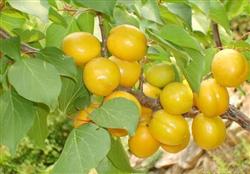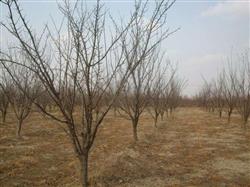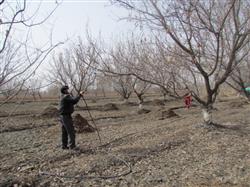Techniques of fertilization and Irrigation Management of Apricot

(1) after the new shoots stopped growing from September to October every year, sufficient basal fertilizer was applied, mainly organic fertilizer such as stable manure and chicken manure, combined with a certain amount of quick-acting fertilizer. the amount of fertilizer should be determined according to the size and growth of the tree, usually 30 kilograms of organic fertilizer per plant, plus about 0.5 kilograms of special compound fertilizer for fruit trees. Topdressing should be carried out before sprouting, hard kernel stage and expansion stage. Before sprouting, the main fertilizer was available nitrogen fertilizer, and urea was applied 0.25 to 0.5 kg per plant. The hardening stage of fruit is dominated by available nitrogen fertilizer, combined with phosphorus and potassium fertilizer, 0.5 kg diammonium phosphate can be applied to each plant. The fruit expansion period is mainly potassium fertilizer, and each plant can apply about 0.5 kg of potassium sulfate. Fertilizer should be applied in trenches and covered with soil in time. In addition, foliar topdressing, spraying urea, potassium dihydrogen phosphate, amino acid compound micro-fertilizer, rare earth micro-fertilizer and so on can be carried out according to the main growth phenology in the whole growing season. (2) in addition to irrigation after each fertilization, one frozen water should be irrigated before freezing, and a small amount of water should be irrigated before buckling the shed, and then covered with plastic film, so as to increase the ground temperature and promote the activity of the root system. After Xiehua, water is irrigated again to promote the growth of young fruits and new fruits, and to remove the plastic film. During the period of fruit hardening and expansion, proper watering according to soil water condition can reduce fruit drop and increase fruit number. Proper control of water before harvest can improve fruit quality and avoid fruit cracking before harvest. After opening the shed, generally do not need to water, lest the branches grow, the tree is too large. Water can be irrigated as appropriate in dry weather.
- Prev

Pest Control of Apricot cultivation
Apricot wasp: the larva overwinters in the apricot kernel or in the apricot nucleus on the branch, the female adult lays eggs between the nuclear skin and the almond, the spawning hole on the fruit surface is not obvious, slightly grayish green, sunken, sometimes there is apricot gum outflow from the spawning hole, and the egg period is about 10 days. The hatched larvae eat almonds in the nucleus, resulting in a large number of fruit drops. Around the beginning of June.
- Next

Winter pruning of apricot trees
As the saying goes, "apricot trees do not harvest in ten years and nine years", in addition to the low fruit setting rate, it is mainly due to the great decrease in the ability of apricot sprouting and flowering to resist low temperature, which is less than-3.9 in bud stage, less than-2.2 in florescence, less than-0.6 in young fruit stage and more than 30 minutes in low temperature period. Freezing injury is easy to occur. So...
Related
- Moge, come on! The staff of the peasant association in the producing area of cantaloupe were frightened when the crowd gathered.
- Causes and Solutions of low Fruit setting rate of Apple
- Symptoms and control measures of passion fruit virus disease
- Fruit growing lesson: how do apple orchards keep high yields?
- Can you build orchards in the mountains? What are the pros and cons?
- How to manage the coloring period of Crisson grape?
- This paper introduces the processing technology of two kinds of fig products.
- How much is a month for retired teachers in rural areas by 2020?
- How can strawberry planting increase sugar content? We should pay attention to management in many aspects.
- What are the cultivation techniques on how to improve the yield of golden fruit?

